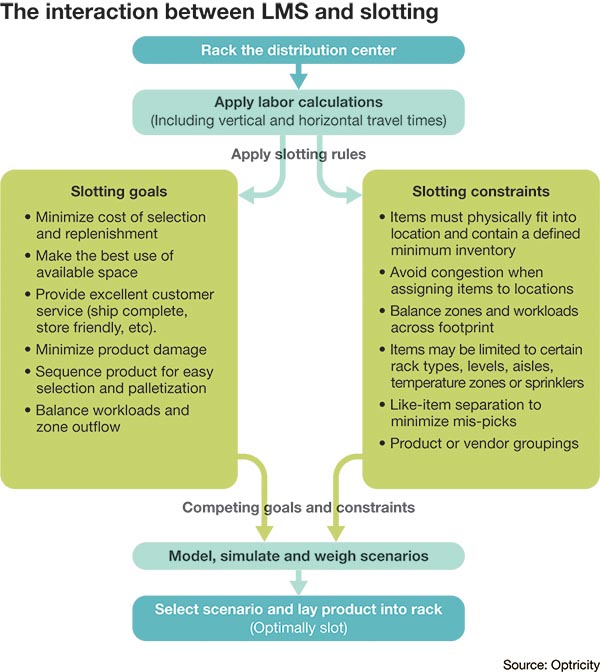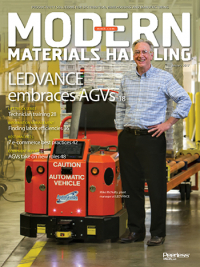Double Up on Labor Efficiencies
With labor costs and complexities rising in the face of omni-channel fulfillment, the combination of slotting and labor management system functions are helping drive better efficiencies.
Is your warehouse operation finally back to normal after the Christmas rush of e-commerce fulfillment? If so, or even if you’re still scrambling to regain composure, now is the time to think about solutions that should make next year go a little more smoothly.
Labor management systems (LMS) and slotting solutions can potentially make warehouse labor more productive. LMS solutions manage against engineered labor standards and optimize workforce assignments, while slotting solutions optimize the placement of stock keeping units (SKUs) in forward pick and other storage areas, minimizing worker travel.
Labor productivity is an increasingly important issue for warehouses. According to Peerless Research Group’s recent annual warehouse operations and trends survey, the inability to attract qualified hourly workers again ranked as a top industry issue, cited by 41% of respondents, up slightly from the year before. The same research found that the number of employees in the average distribution center network now stands at 278 people, up from 236 people four years previous.
To gain greater levels of labor efficiency, LMS and slotting may be the combination more operations need. While LMS is central to managing labor in a more productive way, providers of supply chain execution (SCE) suites that span both LMS and slotting say that slotting’s ability to reduce travel time can significantly enhance labor productivity. At the same time, solution providers say, slotting needs to balance multiple goals, not just cut picker travel time.
Most providers agree that slotting and LMS are complementary, with LMS metrics helping to determine when slotting might be needed, and labor management functions helping to test the labor costs of slotting recommendations. At least some vendors also see slotting practices changing from a seasonal or occasional exercise to a more frequent one.

“We have clients who are literally reslotting part of their warehouse on a daily basis,” says Peter Schnorbach, senior director of product management with Manhattan Associates, an SCE vendor. “They are trying to perform at least a certain number of moves every single day just to keep everything as optimal as possible.”
While the debate continues over how frequently most warehouses need to reslot, vendors agree that users need to be proactive in using slotting, LMS, as well as warehouse management system (WMS) functionality to reduce travel times, boost labor productivity, and keep product in optimal locations, especially given growing multichannel fulfillment complexity. “A lot of the operational issues right now are the result of e-commerce—with the constant introduction of new products and the expansion in the number of SKUs,” says Schnorbach. “All of this [change] creates havoc and is the reason people are reslotting more frequently.”
Slotting and travel
Slotting software optimizes the placement of SKUs in a warehouse based on factors including minimizing pick paths and making it easier to build accurate, damage free, mixed-SKU pallets. Slotting can be offered by large SCE vendors, enterprise system vendors that have SCE offerings, or even by a few best-of-breed slotting vendors.
Minimizing picker travel is perhaps the leading reason to use slotting software to reslot part or all of a facility, but it’s often a balancing act between multiple goals, says Dan Basmajian, president of Optricity, a best-of-breed slotting provider. Optricity’s algorithms consider product characteristics like weight, dimensions and demand/velocity, as well as several other factors including pick path and pallet building.
So while slotting considers multiple factors, says Basmajian, shorter travel times and improved labor productivity are common goals. “We want to make sure we take advantage of the shortest travel times to pick the fast-moving items,” he says.

Other sometimes-crucial constraints include stacking heavy items on the bottom of a pallet to reduce damage and avoid picker congestion, which might happen if a slotting tool simply crams all the fast movers in one small zone, says Basmajian. “One has to balance the cost of travel against the detrimental effects of having congestion,” he says. “And this is what makes slotting kind of difficult, because to slot optimally, you have to consider multiple goals and constraints simultaneously.”
Andy Recard, president of TZA, an LMS vendor, agrees that reducing labor costs is a primary impetus behind slotting, though balanced against other factors including building pallets the way customers want them, avoiding crushing items, and slotting products that tend to be ordered together by their order affinity. “Once you’ve made your logical cuts around factors like stacking heavy items on the bottom, then you absolutely want to reduce travel time,” says Recard.
Recard says that some organizations feed slotting software with data from LMS because a labor system contains precise information on how much travel is involved for pickers and current throughput with the existing locations. Monitoring LMS metrics can also point to the need to reslot. For example, he says, TZA’s system generates a metric called “travel time per line picked” that can serve as a barometer for slotting effectiveness.
Of course, not every warehouse can justify a slotting solution, whether from an SCE vendor or best of breed. A beverage industry warehouse with maybe 150 SKUs isn’t going to have nearly the need for slotting optimization that a 25,000-SKU, half-million-square-foot warehouse serving multiple channels has. “Some companies may not have either the predictability of movement or the SKU proliferation that really warrants a heavy slotting tool,” says Recard.
Jon Kuerschner, vice president of supply chain solutions at HighJump, says some companies make good use of HighJump’s slotting, especially during off-peak times of the year when there’s more labor capacity to apply to slotting moves, but other users find that by properly leveraging HighJump’s core WMS logic around putaway, replenishment and picking, the productivity of the warehouse can be kept at a high level. For example, says Kuerschner, a “pick to clean” logic setting in a WMS can in effect clear locations for faster moving items. “What that can do, in some cases, is preclude the need for slotting,” he says.
Slotting and LMS ties
The ties between slotting and LMS are twofold. For one, labor metrics can help determine whether a reslot is necessary, while labor management functions might also be used to test the costs and benefits of a reslot plan.
“Managers need to understand what the impact of a reslot will be,” says Schnorbach. “What they really want to know is: ‘Will the moves save me money by reducing travel?’ So we are seeing people use labor [management functions] to assess costs prior to making the moves that slotting is telling them to make.”
Throughput rates and “percent of travel time” are two LMS metrics that organizations can examine to help determine if reslotting may be needed, says Dan Grimm, vice president of solutions strategy at JDA Software. Today, says Grimm, most reslotting is driven by seasonal shifts in SKU velocities, but more companies likely could benefit by watching LMS metrics to see if a reslot might help. “If you take it to the next level, inside of a season, or for those operations that don’t have much seasonality, people could be looking at more of those metrics and be more proactive about slotting,” says Grimm.
One of the most useful LMS functions for assessing slotting needs is what amounts to a “heat map” of pick activity, says Ricard. LMS data on which SKUs are moving, the velocity and cube of SKUs, and locations for picks and replenishments are the source data from this type of visual heat map report. “So out of the data we collect, we can very easily generate a heat map and show where the fast moving items are coming from, and if that’s from the back of the warehouse, that’s a flag that some reslotting might be needed,” says Recard.
Grimm says JDA’s software can also offer heat map visualizations, which show shifts in product velocity or if workers have placed a SKU in an unexpected location. While this is not slotting functionality per se, says Grimm, it’s a dashboard feature that makes trends more obvious to the management team.
Executing change
The SCE vendors whose software spans WMS, LMS and slotting point out that an advantage of the suite approach is that it’s easy to pull data from one solution into another to do things like test the labor impacts of a slotting plan. Then, when it’s time to carry out a plan, a common data model approach allows for slotting moves to be interleaved with normal duties.
“To have an execution-oriented slotting solution, you want to be able to take the slotting plan that was created and reviewed, and then be able to execute it easily,” says HighJump’s Kuerschner. “And because we share the same data model, what we are really doing is inserting slotting work into the WMS work queue. The work may originate from slotting, but to the end user, it just looks like a replenishment where you are picking up and putting goods to a location.”
Best-of-breed slotting solutions can integrate with WMS packages, and in some cases vendors have worked together to make the integration easier. For example, Optricity launched an integration partnership with Iptor Supply Chain Systems last year to offer streamlined integration to Iptor’s WMS and enterprise resource planning software.
Another key to effective slotting is the solution’s ability to run simulations and perform “what-ifs” on the impact of slotting options, says Optricity’s Basmajian. “There really needs to be a mechanism by which you can test [slotting recommendations], so we include a simulation module,” Basmajian says. “This simulation component of slotting is crucial.”
To be effective, slotting should not only optimize the forward pick locations for SKUs, but also pinpoint the ideal frequency for replenishment, says Basmajian. In many cases, he adds, a slightly more frequent replenishment cycle can be worth the labor involved because it will make the forward pick zone more dense, meaning less travel for pickers on an ongoing basis.
Effective slotting is all about balancing multiple goals and constraints, and being able to quickly assess options, Basmajian advises. “You can really benefit from at least looking at different options, like the number of targeted days in a forward pick location, and see what the effect is on everything else,” he says. “If the software runs fast and can perform ‘what-ifs,’ then it makes sense to look at those options and pick the best from among the alternatives.”

Article Topics
Software News & Resources
C-suite Interview with Keith Moore, CEO, AutoScheduler.AI: MODEX was a meeting place for innovation C-Suite Interview with Frank Jewell of Datex, Leading the Way in the Material Handling Industry Give your warehouse management systems (WMS) a boost Agility Robotics and Manhattan Associates partner to bring AI-powered humanoid robots into warehouses Siemens, Universal Robots, and Zivid partner to unveil smart robotic picking solution OTTO Motors showcases latest software release for optimizing floor space Rite-Hite ONE digital platform debuts More SoftwareLatest in Materials Handling
Registration open for Pack Expo International 2024 Walmart chooses Swisslog AS/RS and software for third milk processing facility NetLogistik partners with Vuzix subsidiary Moviynt to offer mobility solutions for warehouses Materials Handling Robotics: The new world of heterogeneous robotic integration BSLBATT is looking for new distributors and resellers worldwide Lucas Watson appointed CSO for Körber’s Parcel Logistics business in North America Hyster recognizes Dealers of Distinction for 2023 More Materials HandlingAbout the Author
Subscribe to Materials Handling Magazine

Find out what the world's most innovative companies are doing to improve productivity in their plants and distribution centers.
Start your FREE subscription today.
April 2024 Modern Materials Handling

Latest Resources












